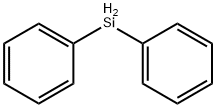
Дифенилсилан
- английское имяDiphenylsilane
- CAS №775-12-2
- CBNumberCB5698855
- ФормулаC12H12Si
- мольный вес184.31
- EINECS212-271-4
- номер MDLMFCD00003002
- файл Mol775-12-2.mol
| Температура плавления | <20°C |
| Температура кипения | 95-97 °C/13 mmHg (lit.) |
| плотность | 0.993 g/mL at 25 °C (lit.) |
| показатель преломления | n |
| Fp | 209 °F |
| температура хранения | Inert atmosphere,2-8°C |
| форма | liquid |
| Удельный вес | 1 |
| цвет | colorless |
| Растворимость в воде | Decomposes in water. |
| Чувствительный | Air & Moisture Sensitive |
| Гидролитическая чувствительность | 3: reacts with aqueous base |
| БРН | 2935887 |
| ИнЧИКей | VDCSGNNYCFPWFK-UHFFFAOYSA-N |
| Справочник по базе данных CAS | 775-12-2(CAS DataBase Reference) |
| FDA UNII | JT2G9H7LNZ |
| Справочник по химии NIST | Silane, diphenyl-(775-12-2) |
| Система регистрации веществ EPA | Silane, diphenyl- (775-12-2) |
| UNSPSC Code | 12352103 |
| NACRES | NA.22 |
| Коды опасности | Xi | |||||||||
| Заявления о рисках | 38-36/37/38 | |||||||||
| Заявления о безопасности | 37/39-26 | |||||||||
| WGK Германия | 1 | |||||||||
| F | 10-21 | |||||||||
| TSCA | Yes | |||||||||
| кода HS | 29310095 | |||||||||
| NFPA 704: |
|
рисовальное письмо(GHS)
-
рисовальное письмо(GHS)

-
сигнальный язык
предупреждение
-
вредная бумага
H315:При попадании на кожу вызывает раздражение.
H319:При попадании в глаза вызывает выраженное раздражение.
-
оператор предупредительных мер
P264:После работы тщательно вымыть кожу.
P280:Использовать перчатки/ средства защиты глаз/ лица.
P302+P352:ПРИ ПОПАДАНИИ НА КОЖУ: Промыть большим количеством воды.
P305+P351+P338:ПРИ ПОПАДАНИИ В ГЛАЗА: Осторожно промыть глаза водой в течение нескольких минут. Снять контактные линзы, если Вы ими пользуетесь и если это легко сделать. Продолжить промывание глаз.
P332+P313:При возникновении раздражения кожи: обратиться за медицинской помощью.
P337+P313:Если раздражение глаз не проходит обратиться за медицинской помощью.
Дифенилсилан химические свойства, назначение, производство
Химические свойства
clear colorless liquidИспользование
Thiocarbonyl derivatives of secondary alcohols are readily reduced by diphenylsilane in a radical chain process at room temperature using triethylborane-air as an initiator. An improved radical chain procedure for the deoxygenation of secondary and primary alcohols using diphenylsilane as hydrogen atom donor and triethylborane-air as initiator. Diphenylsilane is a reagent in the invention of radical reactions for deoxygenation of alcohols via their thiocarbonyl derivatives, deamination via isonitriles, and dehalogenation of bromo- and iodo- compounds by radical chain chemistry. Fluorescent film sensor for vapor-phase nitroaromatic explosives via monolayer assembly of oligo(diphenylsilane) on glass plate surfaces. Reductions of carboxylic acid derivatives by silanes in the presence of rhodium complexes were studied. Carboxylic esters were reduced to alcohols by diphenylsilane catalyzed by [RhCl (cod)] 2/4PPh 3 or [RhCl (PPh 3) 3] at room temperature in up to 99% yields. Sequential C- Si bond formations from diphenylsilane and its application to silanediol peptide isostere precursors.Синтез
A method for preparing diphenylsilane comprises the following steps: adding diphenylchlorosilane in a tetrahydrofuran solution dissolved with a catalyst, carrying out a reaction at the temperature of -10-0 ℃, after the completion of the reaction is monitored by a TLC method, adding the product into an inorganic acid dilute solution under an ice bath condition, and extracting an organic layer, to obtain diphenylsilane. The methods have the advantages that the production processes are greatly simplified, the production costs are low, the purity of the products is high, the content of by-products is low, and the separation is relatively convenient.Методы очистки
Dissolve it in Et2O, mix slowly with ice-cold 10% AcOH. The Et2O layer is then shaken with H2O until the washings are neutral to litmus. Dry over Na2SO4, evaporate the Et2O and distil the residual oil under reduced pressure using a Claisen flask with the take-off head modified into a short column. Ph2SiH2 boils at 257o/760mm, but it cannot be distilled at this temperature because exposure to air leads to flashing, decomposition and formation of silica. It is a colourless, odourless oil, miscible with organic solvents but not H2O. A possible impurity is Ph3SiH which has m 43-45o and would be found in the residue. [West & Rochow J Org Chem 18 303 1953, Benkhesser et al. J Am Chem Soc 74 648 1952, Gilman & Zuech J Am Chem Soc 81 5925 1959, Beilstein 16 IV 1366.]Дифенилсилан запасные части и сырье
Дифенилсилан поставщик
| поставщик | телефон | страна | номенклатура продукции | благоприятные условия | |
|---|---|---|---|---|---|
| +86-21-59960785 +86-17701845089 |
China | 338 | 58 | ||
| +86-13131129325 | China | 5887 | 58 | ||
| +86-371-66670886 | China | 19902 | 58 | ||
| +86-0371-55170693 +86-19937530512 |
China | 21632 | 55 | ||
| 008657128800458; +8615858145714 |
China | 7738 | 55 | ||
| +undefined-21-51877795 | China | 32965 | 60 | ||
| +86-0371-86658258 +8613203830695 |
China | 29871 | 58 | ||
| +86-755-89396905 +86-15013857715 |
China | 10453 | 58 | ||
| +86-25-18512596065 | CHINA | 933 | 58 | ||
| +1-858-6993322 | United States | 18526 | 58 |